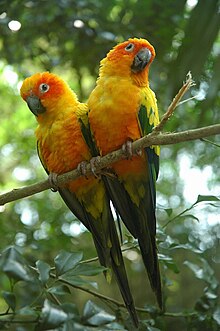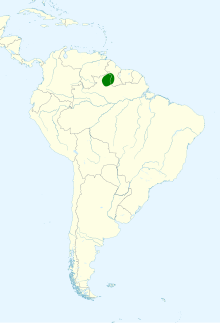Sun conure
| Sun conure | |
|---|---|

| |
| Scientific classification | |
| Domain: | Eukaryota |
| Kingdom: | Animalia |
| Phylum: | Chordata |
| Class: | Aves |
| Order: | Psittaciformes |
| Family: | Psittacidae |
| Genus: | Aratinga |
| Species: | A. solstitialis
|
| Binomial name | |
| Aratinga solstitialis | |

| |
| Synonyms | |
| |
The sun conure (Aratinga solstitialis), also known as the sun parakeet, is a medium-sized, vibrantly colored
Taxonomy
The sun conure was one of the many species originally described by
However, this is the only species of "conure" that is regularly referred to as such in ornithological circles; most others are called "parakeets" by authorities.The sun conure is
The sun conure is the closest living relative of the extinct Carolina parakeet and as such, its genes have been sequenced for comparative purposes, in relation to studying the genome of the latter species.[7] The two species last shared a common ancestor about 3 million years ago, coinciding with the closure of the Isthmus of Panama, which allowed easier dispersal of species between North and South America.[8]
Description

On average, sun conures weigh around 110 g (4 oz) and are around 30 cm (12 in) long.[9] The sexes are similar in plumage, although hens may be lighter and slenderer in body, having a shorter tail, with a smaller, rounder head and a smaller beak.[10] Adults have a rich yellow crown, nape, mantle, lesser wing coverts, tips of the greater wing coverts, chest, and underwing coverts. The face and belly are orange with red around the ears. The base of the greater wing coverts, tertials, and base of the primaries are green, while the secondaries, tips of the primaries, and most of the primary coverts are dark blue. The tail is olive-green with a blue tip. From below, all the flight feathers are dark greyish. The bill is black. The legs and the bare eye ring are grey, but the latter often fades to white in captivity (so using amount of grey or white in the eye ring for determining "purity" of an individual can be misleading). It is easily confused with the closely related jandaya parakeet and sulphur-breasted parakeet, but the former has entirely green wing coverts, mantle, and vent, while the latter has green mottling to the mantle and less orange to the underparts. The sun conure is also superficially similar to the pale-billed golden parakeet.
Juvenile sun conures display a predominantly green plumage and resemble similarly aged sulphur-breasted parakeets. The distinctive yellow, orange, and reddish colouration on the back, abdomen, and head is attained with maturity.
Distribution and habitat
Sun conures live in a relatively small region of northeastern South America - the north Brazilian state of Roraima, southern Guyana, extreme southern Suriname, and southern French Guiana. They also occur as vagrants to coastal French Guiana. Their status in Venezuela is unclear, but recent sightings from the southeast near Santa Elena de Uairén have been reported. They may occur in Amapá or far northern Pará (regions where the avifauna generally is very poorly documented), but this remains to be confirmed. Populations found along the Amazon River in Brazil are now known to belong to the sulphur-breasted parakeet.[11]
Sun conures are mostly found in tropical habitats, but their exact ecological requirements remain relatively poorly known. They are widely reported as occurring within dry savanna woodlands and coastal forests, but recent sightings suggest they mainly occur at altitudes less than 1200 m, at the edge of humid forests growing in foothills in the Guiana Shield, and cross more open savannah habitats only when traveling between patches of forest. Sun conures have been seen in shrublands along the Amazon riverbank, as well as forested valleys and coastal, seasonally flooded forests. These conures usually inhabit fruiting trees and palm groves.[12]
Behavior

Like other members of the genus Aratinga, the sun conure is very social and typically occurs in large flocks of 15 to 30 individuals. They rarely leave the flock, but when they get separated from the group, they squawk and scream in a high-pitched voice, which can carry for hundreds of yards, allowing individuals to communicate with their flock and return to them. Flocks are relatively quiet while feeding, but are known to be very vocal and make loud noises when in flight. They can travel many miles in a single day, and they are fast, direct flyers. Nonverbal communication is also practised, with a variety of physical displays. Birds within a flock rest, feed one another, preen, and bathe throughout the daylight hours. They move through the trees using their beaks for extra support. They also have the ability to use their feet like hands to help hold, examine, or eat items.[13] Sun conures have been reported to nest in palm cavities. When in molt, conures are uncomfortable, so are easily irritable. Bathing, warm rainfalls, and humidity allow the sheaths of each pin feather to open more easily and lessen their discomfort. Sun conures are extremely smart and curious, so require constant mental stimulation and social interaction. Their speech and ability to learn tricks in captivity are quite moderate. Otherwise, relatively little is known about their behavior in the wild, in part due to confusion with the sulphur-breasted parakeet species. Regardless, the behavior of the two is unlikely to differ to any great extent.[10]
Diet

In the wild, sun conures mainly feed on fruits, flowers, berries, blossoms, seeds, nuts, and insects. They feed on both ripe and half-ripe seeds of both fruits and berries. They also consume red cactus fruit, Malpighia berries, and legume pods. At times, they forage from agricultural crops and may be considered pests. They require more protein intake during breeding season, more carbohydrates when rearing young, and more calcium during egg production.
In captivity, their diets may include grass seeds, beans, nuts, fruits (apples, papaya, bananas, oranges, grapefruits, strawberries, raspberries, blackberries, gooseberries, currants, rowans, elderberries, hawthorn berries, rose hips, cucumbers, and tomatoes), vegetables (spinach, Chinese cabbage, cress, roquette, kale, broccoli, carrots, alfalfa, peas, endive, and sweet potatoes), dandelions, chickweed, soaked corn, germinated sunflower seeds, and spray millet. They may also eat fruit tree buds (elderberry bushes, willows, hawthorn, and aspen), ant eggs, mealworms or their substitutes (hard-boiled eggs, bread, biscuits, hard cheese or low-fat cottage cheese). Cuttle bones, mineral blocks, and gravel or ground oyster shells may be given to aid in mechanical digestion.[10]
Reproduction

Young sun conures form monogamous pairs around 4 to 5 months of age.[
Status
Sun conures are currently endangered, with their population numbers declining rapidly due to loss of habitat, hunting for plumage, and being excessively wild caught – about 800,000 each year, for the pet trade. Now, more sun conures are living in people's homes than in the wild. Since the Wild Bird Conservation Act was put in place in 1992 to ban the importation of parrots (including sun conures) into the United States, they are more frequently bred in captivity for domestication purposes. Similarly, the European Union more recently banned the importation of wild-caught birds in 2007. These legislations may help increase their population in the wild.[14]
In the past, the sun conure has been considered safe and listed as
Aviculture

The sun conure is noted for its very loud squawks and screams compared to its relatively small size, and have been recorded reaching over 120 decibels.[15] It is capable of mimicking humans, but not as well as some larger parrots. It is popular as a pet because of its bright coloration and curious nature. Due to its inquisitive temperament, it demands a great deal of attention from owners, with whom it can be loving and cuddly. Hand-reared pets can be very friendly towards people with whom they are familiar, but they may be aggressive with strangers and even territorial with visitors.[16] Sun conures are capable of learning many tricks and can even perform in front of a live audience. They enjoy listening to music, to which they occasionally sing and dance. Like many parrots, they are determined chewers and require toys and treats on which to chew. Other activities enjoyed by sun conures include taking baths and preening feathers. Many owners clip their conures' wings, but this is not necessary if the proper precautions are put in place. Due to environmental hazards, conures should not be allowed to fly unsupervised. Sun conures are great candidates for outdoor flight when well trained, as they are loyal, but risk potential must be minimized. In captivity, their lifespans range from 15 to 30 years.[12]
A red-factor colour mutation has been produced in aviculture. Originating in Hawaii in the early 2000s, this mutation results in the parakeet's normal yellowish plumage being replaced by a deep reddish-orange, the intensity of which varies from individual to individual. The genetics and inheritance mode of the mutation are poorly understood at present and some red-factor birds that exhibit extremely reddish color fail to thrive, display health problems, and die within months of hatching, with brain and spleen abnormalities apparent upon autopsy.[17]
References
- ^ . Retrieved 12 November 2021.
- ^ Linnaeus, Carl (1758). Systema naturae per regna tria naturae, secundum classes, ordines, genera, species, cum characteribus, differentiis, synonymis, locis. Tomus I. Editio decima, reformata (in Latin). Holmiae. (Laurentii Salvii). p. 824. Archived from the original on 2015-03-19.
- ISBN 0-304-52257-0.
- ^ "SUN CONURE (Aratinga solstitialis)". World Parrot Trust. Retrieved 20 February 2022.
- ISBN 3-9805291-1-8
- ^ Silverira, L., de Lima, F., & Höfling, E. (2005). A new species of Aratinga Conure (Psittaformes: Psittacidae) from Brazil, with taxonomical remarks on the Aratinga solstitialis complex. The Auk 122(1): 292–305.
- ^ Katz, Brigit. "The Extinction of This U.S. Parrot Was Quick and Driven by Humans". Smithsonian Magazine. Retrieved 14 July 2023.
- ^ GrrlScientist. "DNA Study Points To Humans As Cause of Carolina Parakeet Extinction". Forbes. Retrieved 5 August 2023.
- ^ Sun Conure Parrot. PBase.com
- ^ a b c d "Aratinga solstialis". Animal Diversity Web.
- ^ "Sun Conure". Beauty of Birds. 16 September 2021.
- ^ a b "Sun-conure-parrot". Feather me.
- ^ Jayne Hardwick. "Sun Conure".
- ^ "Sun conures". My conure.
- ^ "Are Sun Conures Louder Than Macaws? The Differences – Beak Craze". Retrieved 2022-09-09.
- ^ Sun Conure. theparrotplace.co.nz
- ^ Covault, Marcy. "The Red Factor Sun Conure Color Mutation" (PDF). Feathered Companions Aviary. Retrieved 5 January 2021.
Further reading
- Hilty, S. (2003). Birds of Venezuela, 2nd edition. Princeton University Press, New Jersey. ISBN 0-691-02131-7
- Juniper, T., & Parr, M. (1998). A Guide to the Parrots of the World. Pica Press, East Sussex. ISBN 1-873403-40-2
- Jutglar, Á. (1997). Aratinga solstitialis (Sun Conure). p. 431 in: del Hoyo, J., Elliott, A., & Sargatal, J. eds (1997). Handbook of Birds of the World. Vol. 4. Sandgrouse to Cuckoos. Lynx Edicions, Barcelona. ISBN 84-87334-22-9
- Restall, R., Rodner, C., & Lentino, M. (2006). Birds of Northern South America – An Identification Guide. Vol. 1: Species Accounts. Helm, London. ISBN 0-7136-7242-0
- Recognize Aratinga pintoi as a valid species. South American Classification Committee.
- Teitler, R., 1981. Taming and Training Conures. T.F.H. Publications, Inc. Ltd. England.
External links
- "Sun parakeet – BirdLife Species Factsheet". BirdLife International (2008). Retrieved 3 January 2009.
- Stamps[usurped] (for Guyana) with RangeMap

